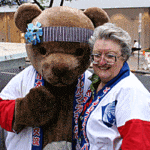Cape Krusenstern National Monument, Alaska
Cape Krusenstern National Monument is another of the five Western Arctic National Parklands. Although it is only about 10 miles across Kotzebue Bay, you still have to get there by bush plane. (Do I dare mention, no roads?) It is comprised of a coastal plain with about 70 miles of land facing the Chukchi Sea. The sea with its ice bergs and harsh winters continues to carve out ever changing lagoons in this parkland. The result is perfect breeding grounds for a number of migratory birds, like Canadian jays, gulls, sandhill cranes, arctic loons, and American golden plovers. I was fascinated about the Sand Hill Cranes, for an endangered species to survive so abundantly in such a harsh climate. In addition there are both black and brown (grizzly) bears. They like to walk the shoreline looking for carcasses washed in by the sea. Lazy buggers!
The land appears pretty bleak, except in springtime when the hills are alive in wildflowers. This is one attraction for the Western Arctic Caribou herd, which is now estimated at around 450,000 to half a million in population. They wander around the parklands up here in small numbers trying to escape the mosquitoes and flies before forming up herds in the fall to migrate again. Wolves and wolverines are also present – guess it must be that “subway” on the hoof.
There are 114 ridges in this park, caused by the pressures of the seas and behind the ridges there is evidence of human habitation as old as 9,000 years ago. Close to the Bering Land Bridge, it was probably settled early by man after migration. They could live off the resources, much as the modern-day descendants do today, of both sea and land. The land provided grazing animals and birds, the sea provided other creatures like whales, seals, walruses and polar bears. In addition, the muskox live here. They are perfectly adapted to this barren land, they do not migrate, but live here year round. And their slow languid pace helps them persevere in the climate. Originating on the slopes in Siberia, they probably used that close by land bridge to migrate to the North American continent and ranged at one time as far south as Kansas and Illinois ( where there have been muskox bones found ) They graze on the tundra land and they are well insulated by their heavy fur, topped with Qiviut, which is the soft undercoat (and makes wonderful sweaters, ladies).
This parkland is perfect for kayakers, and birders. Animal watchers will love this place too, there is plenty to observe. As usual, charter plane from Kotzebue, make it a day trip, but plan to do enough overfly’s to spot caribou, and muskoxen. You will land on the beach. Hey, you take the runways where you can find them in the Arctic North.

